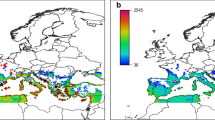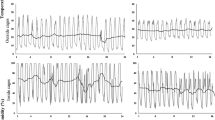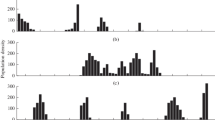Abstract
Relative effects of weather and three-trophic interactions were studied for a classical biological control system consisting of the arrowhead scale Unaspis yanonensis, known formerly as a serious pest of the Satsuma mandarin orange Citrus unshiu, and its two introduced parasitoids, Coccobius fulvus and Aphytis yanonensis. Yearly population responses of the three insect species on a per-tree basis for up to 10 years at two orange groves were analyzed by general linear models, with a backward stepwise procedure, to select among abiotic (summer/winter temperature and rainfall) and biotic (densities of the three insect species and orange bearing in the previous years) independent variables. Temperature positively affected the arrowhead scale and the two parasitoids. A negative correlation of rainfall was detected for all three insect species. Mandarin fruiting showed negative delayed density dependence, thereby supporting the observed alternate bearing phenomenon in mandarins, presumably due to physiological imbalance triggered by climatic factors. The arrowhead scale was negatively correlated with fruit production in the preceding years, possibly due to reduced resistance in subsequent years of mast fruiting. We found a negative correlation of the arrowhead scale with Coccobius only in a single grove and none with Aphytis. Thus, it appears that bottom-up forces may be more important than top-down control by the parasitoids in the post-transient phase of this system.





Similar content being viewed by others
References
Andrewartha HG, Birch LC (1948) Measurement of environmental resistance in the Australian plague grasshopper. Nature 161:447–448
Bale JS, Harrington RL, Clough MS (1988) Low temperature mortality of the peach-potato aphid Myzus persicae. Ecol Entomol 13:121–129
Bale JS, Masters GJ, Hodkinson ID, Awmack C, et al (2002) Herbivory in global climate change research: direct effects of rising temperature on insect herbivores. Glob Change Biol 8:1–16
Davis AJ, Lawton JH, Shorrocks B, Jenkinson LS (1998) Individualistic species responses invalidate simple physiological models of community dynamics under global environmental change. J Anim Ecol 67:600–612
DeBach P (1958) The role of weather and entomophagous species in the natural control of insect populations. J Econ Entomol 51:474–484
Fox JW, Morin PJ (2001) Effects of intra- and interspecific interactions on species responses to environmental change. J Anim Ecol 70:80–90
Furuhashi K, Nishino M (1983) Biological control of arrowhead scale, Unaspis yanonensis, by parasitic wasps introduced from the Peoples Republic of China. Entomophaga 28:277–286
Furuhashi K, Ohkubo N (1990) Use of parasitic wasps to control the arrowhead scale (Hom., Diaspidae), in Japan. FFTC Book Series 40:71–81
Hashimoto S, Miyaji K, Gyoutoku Y, Watanabe Y, Kai I, Tamura I, Ujiye T, Kashio T (1988) Dispersion of Aphytis yanonensis and Coccobius fulvus, introduced parasitoids of arrowhead scale, Unaspis yanonensis in Kyushu in 1987. II. Southern part of Kyushu (in Japanese). Proc Assoc Pl Prot Kyushu 34:169–175
IPCC (2000) Summary for policy makers, emissions scenarios. Special report of the Intergovernmental Panel on Climate Change, Geneva, 2000
Itioka T, Inoue T, Matsumoto T, Ishida N (1997) Biological control by two exotic parasitoids: eight-year population dynamics and life tables of the arrowhead scale. Entomol Exp Appl 85:65–74
Kihara T, Konakahara M (2000) Present status and countermeasure for biennial bearing in Stsuma mandarin trees (in Japanese with English summary). Bull Natl Inst Fruit Tree Sci 34:111–136
Kiritani K (2005) Predicting impacts of global warming on population dynamics and distribution of arthropods in Japan. Popul Ecol DOI: 10.1007/s10144-005-0225-0
Koike T, Tobita H, Shibata T, Matsuki S, Konno K, Kitao M, Yamashita N, Maruyama Y (2005) Defense characteristics of seral deciduous broad-leaved tree seedlings grown under differing levels of CO2 and nitrogen. Popul Ecol DOI: 10.1007/s10144-005-0236-x
Korenaga R (1983) The time of hatching and crawling speed of Unaspis yanonensis (Homoptera: Coccidae) (in Japanese with English summary). Jpn J Appl Entomol Zool 27:308–309
Korenaga R, Sakagami Y, Okudai S (1976) The effect of temperature on the development of the arrowhead scale, Unaspis yanonensis Kuwana. II. Development of the first generation under fluctuating temperature (in Japanese with English summary). Bull Fruit Tree Res Sta B 3:47–56
Korenaga R, Hirosaki S, Shiyomi M (1978) Models for prediction of the population density of the arrowhead scale, Unaspis yanonensis Kuwana, on citrus tree by multiple regression analysis II (in Japanese with English summary). Jpn J Appl Entomol Zool 25:17–25
Korenaga R, Sakagami Y, Komazaki S (1980) Effect of temperature on the development of the arrowhead scale, Unaspis yanonensis Kuwana. III. Development of the second generation under constant and fluctuating temperatures (in Japanese with English summary). Bull Fruit Tree Res Stn B 7:99–108
Korenaga R, Shiyomi M, Hirosaki S, Nakamura K, Ito S, Kimura Y, Uemura M (1981) Models for prediction of the population density of the arrowhead scale, Unaspis yanonensis Kuwana, on citrus tree by multiple regression (in Japanese with English summary). Jpn J Appl Entomol Zool 22:141–151
Kudo G, Hirao AS (2005) Habitat-specific responses in the flowering phenology and seed set of alpine plants to climate variation: implications for global-change impacts. Popul Ecol DOI: 10.1007/s10144-005-0242-z
Matsumoto T, Itioka T, Nishida T (2002) Fitness cost of parasitoid avoidance behavior in the arrowhead scale, Unaspis yanonensis Kuwana. Entomol Exp Appl 105:83–88
Matsumoto T, Itioka T, Nishida T (2003a) Rapid change in the settling behavior of the arrowhead scale Unaspis yanonensis as an avoidance mechanism against introduced parasitoids, Aphytis yanonensis and Coccobius fulvus. Entomol Exp Appl 107:105–113
Matsumoto T, Itioka T, Nishida T, Inoue T (2003b) Introduction of parasitoids has maintained a stable population of arrowhead scales at extremely low levels. Entomol Exp Appl 106:115–125
Matsumoto T, Itioka T, Nishida T, Kaneko S (2003c) Is one parasitoid enough? A test comparing one with a pair of parasitoid species in the biological control of arrowhead scales. Popul Ecol 45:61–66
Matsumoto T, Itioka T, Nishida T (2004a) Is spatial density dependent parasitism necessary for successful biological control? Testing a stable host-parasitoid system. Entomol Exp Appl 110:191–200
Matsumoto T, Itioka T, Nishida T (2004b) Why can arrowhead scales, Unaspis yanonensis Kuwana (Homoptera: Diaspididae), which burrow and settle below conspecifics, successfully avoid attack by its parasitoid, Coccobius fulvus Compere et Annecke (Hymenoptera: Aphelinidae)? Appl Entomol Zool 39:147–154
Matsumoto T, Itioka T, Nishida T, Inoue T (2004c) A test of temporal and spatial density dependence in the parasitism rates of introduced parasitoids on host, the arrowhead scale (Unaspis yanonensis) in stable host-parasitoids system. J Appl Entomol 128:267–272
Millar JG, Hare JD (1993) Identification and synthesis of a kairomone inducing oviposition by parasitoid Aphytis melinus from California red scale covers. J Chem Ecol 19:1721–1736
Milne A (1957) Theories of natural control of insect populations. Cold Spring Harbor Symp Quant Biol 22:253–271
Monseliese SP, Goldschmidt EE (1982) Alternate bearing in fruit trees. Hortic Rev 4:128–178
Nagasaki Prefecture (2001) Annual Report of Agriculture (in Japanese). For Fish Stat Nagasaki Rep. no. 48
Nagasaki Prefecture (2004) Annual Report of Agriculture (in Japanese). For Fish Stat Nagasaki Rep no. 51
Nicholson AJ (1933) The balance of animal populations. J Anim Ecol 2:132–178
Nishimori M, Ishigooka Y, Yokozawa M, Toritani H (2005) Future climate change scenario in Asian region by using the output from the latest GCM experiments. In: Proc Joint Meet Environ Eng Agric 2005 (in press)
Nohara K, Tasaka T (1965) On the relation between the chemical components of the leaves of Citrus natsudaidai Hayata and the population density of Unaspis yanonensis Kuwana (in Japanese with English summary). Sci Bull Fac Agric Kyushu Univ 22:23–27
Ogata T (1987) Effect of temperature on the development of Coccobius fulvus (Compere et Annecke) (Hymenoptera: Aphelinidae), an introduced parasitoid of the arrowhead scale, Unaspis yanonensis (Kuwana) (Homoptera: Diaspididae) (in Japanese with English summary). Jpn J Appl Entomol Zool 31:168–169
Ohgaki C, Fujita K, Ito H (1965) Investigations on the cause and control of alternate bearing of Unshu orange trees. VI. Seasonal change of nitrogen, phosphorus and potassium absorption in alternate and annual bearing trees (in Japanese with English summary). J Jpn Soc Hortic Sci 35:8–18
Ohgushi R (1969) Ecology of insect pests on citrus (in Japanese). Nosan-gyoson Bunka Kyokai, Tokyo
Ohgushi R, Nishino T (1966) On the winter mortality of arrowhead scale, Prontaspis yanonensis Kuwana (in Japanese with English summary). Jpn J Appl Entmol Zool 10:7–16
Ohkubo N, Kuchiki F, Tsutsumi T, Gyoutoku Y, Ujiye T, Kashio T (1988) Dispersion of Aphytis yanonensis and Coccobius fulvus, introduced parasitoids of arrowhead scale, Unaspis yanonensis in Kyushu in 1987. I. Northern part of Kyushu (in Japanese). Proc Assoc Pl Prot Kyushu 34:161–168
Okada N, Katayama H, Suzuki H (1992) Effects of summer precipitation on the leaching losses of applied nitrogen and potash from subsoil (in Japanese with English summary). Bull Shizuoka Citrus Exp Sta 24:1–13
Okudai S, Korenaga R (1966) On the geographical distribution of the arrowhead scale, Unaspis yanonensis, in Japan. I. On the geographical distribution in citrus region in the Pacific Ocean zone (in Japanese with English summary). Bull Hortic Res Sta B 5:139–148
Okudai S, Korenaga R, Sakagami Y (1968) On the geographical distribution of the arrowhead scale, Unaspis yanonensis, in Japan. II. On the geographical distribution in citrus region in the Japan Sea zone and the inland area (in Japanese with English summary). Bull Hort Res Sta B 8:121–134
Okudai S, Korenaga R, Sakagami Y (1971) The effect of temperature on the development of the arrowhead scale, Unaspis yanonensis. I. Development of the first generation under the constant temperatures (in Japanese with English summary). Bull Hort Res Sta B 11:193–201
Okudai S, Korenaga R, Sakagami Y (1974) Studies on the autumnal appearance of larvae of the arrowhead scale, Unaspis yanonensis Kuwana. II. On the relationship between temperature in the early stage of the autumn adults and the autumnal appearance of larvae (in Japanese with English summary). Bull Fruit Tree Res Stn B 1:101–113
Okudai S, Korenaga R, Sakagami Y (1975) Effect of temperature on the ovarian development of the arrowhead scale, Unaspis yanonensis Kuwana, in the late hibernating period (in Japanese with English summary). Bull Fruit Tree Res Stn B 2:97–106
Parmesan C (1996) Climate and species’ range. Nature 382:765–766
Parmesan C, Ryrholm N, Stefanescu C, Hill JK, Thomas CD, Descimon H, Huntley B, Kaila L, Kullberg J, Tammaru T, Tennent WJ, Thomas JA, Warren M (1999) Poleward shifts in geographical ranges of butterfly species associated with regional warming. Nature 399: 579–583
Parmesan C, Root TL, Willig MR (2000) Impacts of extreme weather and climate on terrestrial biota. Bull Am Meteor Soc 81:443–450
Pollard E, Yates TJ (1993) Monitoring butterflies for ecology and conservation. Chapman & Hall, London
Redfern M, Hunter MD (2005) Time tells: long-term patterns in the population dynamics of the yew gall midge, Taxomyia taxi (Cecidomyiidae), over 35 years. Ecol Entomol 30:86–95
SAS Institute (2000) JMP statistics and graphics guide, version 4.0. SAS Institute, Cary, NC
Spiegel-Roy P, Goldschmidt EE (1996) Biology of citrus. Cambridge University Press, Cambridge
Takagi K (1983) Establishment of Aphytis sp. and Physcus fulvus (Hymenoptera: Aphelinidae), imported parasitoids of arrowhead scale, Unaspis yanonensis (Homoptera: Diaspididae), on citrus grove in Japan (in Japanese with English summary). Bull Fruit Tree Res Sta D5:93–110
Takagi M, Ogata T (1990) Reproductive potential of Aphytis yanonensis Debach et Rosen and Coccobius fulvus (Compere et Annecke) (Hymenoptera: Aphelinidae), parasitoids of Unaspis yanonensis (Kuwana) (Homoptera: Diaspididae). Appl Entomol Zool 25:407–408
Tauber MJ, Tauber CA, Masaki S (1986) Seasonal adaptations of insects. Oxford University Press, Oxford
Tuda M, Fujii K (1993) Effects of temperature increase on insect community. In: Oshima Y (ed) Proc Int Symp Global Change (IGBP). pp 554–560
Tuda M, Shimada M (1995) Developmental schedules and persistence of experimental host-parasitoid systems at two different temperatures. Oecologia 103:283–291
Walther G-R, Post E, Convey P, Menzel A, Parmesan C, Beebee TJC, Fromentin JM, Hoegh-Guldberg O, Bairlein F (2002) Ecological responses to recent climate change. Nature 416:389–395
Weisser WW, Volkl W, Hassell MP (1997) The importance of adverse weather conditions for behaviour and population ecology of an aphid parasitoid. J Anim Ecol 66:386–400
Yamamura K (1999) Transformation using (x + 0.5) to stabilize the variance of populations. Res Popul Ecol 41:229–234
Yamamura K, Kiritani K (1998) A simple method to estimate the potential increase in the number of generations under global warming in temperate zones. Appl Entomol Zool 33:289–298
Yamamura K, Yokozawa M, Nishimori M, Ueda Y, Yokosuka T (2005) How to analyze long-term insect population dynamics under climate change: 50-year data of three insect pests in paddy fields. Popul Ecol DOI: 10.1007/s10144-005-0239-7
Yukawa J, Akimoto K (2005) Influence of synchronization between adult emergence and host plant phenology on the population density of Pseudasphondylia neolitseae (Diptera: Cecidomyiidae) inducing leaf galls on Neolitsea sericea (Lauraceae). Popul Ecol DOI: 10.1007/s10144-005-0233-0
Acknowledgements
We thank George Heimpel for his comments on the earlier version of the manuscript. This study was supported by Grant-in-Aids for Scientific Research (10660050, 11308021 and 12740424).
Author information
Authors and Affiliations
Corresponding author
Rights and permissions
About this article
Cite this article
Tuda, M., Matsumoto, T., Itioka, T. et al. Climatic and intertrophic effects detected in 10-year population dynamics of biological control of the arrowhead scale by two parasitoids in southwestern Japan. Popul Ecol 48, 59–70 (2006). https://doi.org/10.1007/s10144-005-0243-y
Received:
Accepted:
Published:
Issue Date:
DOI: https://doi.org/10.1007/s10144-005-0243-y




